Kenji Kawano was hitchhiking on the Navajo Nation when Carl Gorman pulled over to present him a elevate. In the course of the drive, Kawano, then 23, defined that he’d arrived within the U.S. two years earlier with plans to journey the nation taking footage, hoping to construct a portfolio that might land him a gig as knowledgeable photographer.
“The place you from?” Gorman requested.
“Japan,” Kawano replied.
Then Gorman requested if Kawano had ever heard of the Navajo code talkers.
Kenji Kawano at Arizona’s Monument Valley. He first discovered in regards to the code talkers whereas hitchhiking on Navajo Nation territory.
(Courtesy of Bazhnibah)
Throughout World Conflict II, a gaggle of Navajo Marines had created a secret code based mostly on their language to transmit phone and radio messages within the Pacific. Japanese cryptographers had been breaking U.S. army codes — seemingly at will — and Navajo, a fancy, little-known, tonal language, turned out to be an ideal answer to a dire drawback.
The code was by no means damaged, and on Iwo Jima alone, the code talkers, incessantly known as America’s secret weapon in the course of the struggle, despatched greater than 800 error-free messages within the fierce battle for the island. Earlier than the tip of the struggle, there have been roughly 400 Navajo code talkers, and Gorman was certainly one of them.
Marines who used language, not weapons, to battle a struggle?
“I assumed it could possibly be an excellent picture undertaking,” Kawano stated. He had no concept that this opportunity desert encounter in 1975 would take over his life.
Utilizing Fuji movie, an previous pickup truck, a smattering of Navajo, a beneficiant serving to of humility and unbelievable tenacity, Kawano grew to become the premier chronicler of this revered fraternity. For greater than 40 years, he’s produced books of code talker pictures and arranged displays around the globe, turning into their official photographer.
“Plenty of the general public recognition of those males and getting their names on the market is because of Kenji’s images,” stated Zonnie Gorman, a code talker historian and the daughter of Carl Gorman, who died in 1998. “He developed a deep tie with these males and their households. It takes lots to win over a Navajo, however when you do, you’re caught with us for all times.”
Time is operating quick — a corps of 400 has dwindled to 3 — however Kawano continues to doc the ultimate moments and recollections of the boys who participated in each main Marine assault within the Pacific, hoping his work will protect their legacy for future generations.
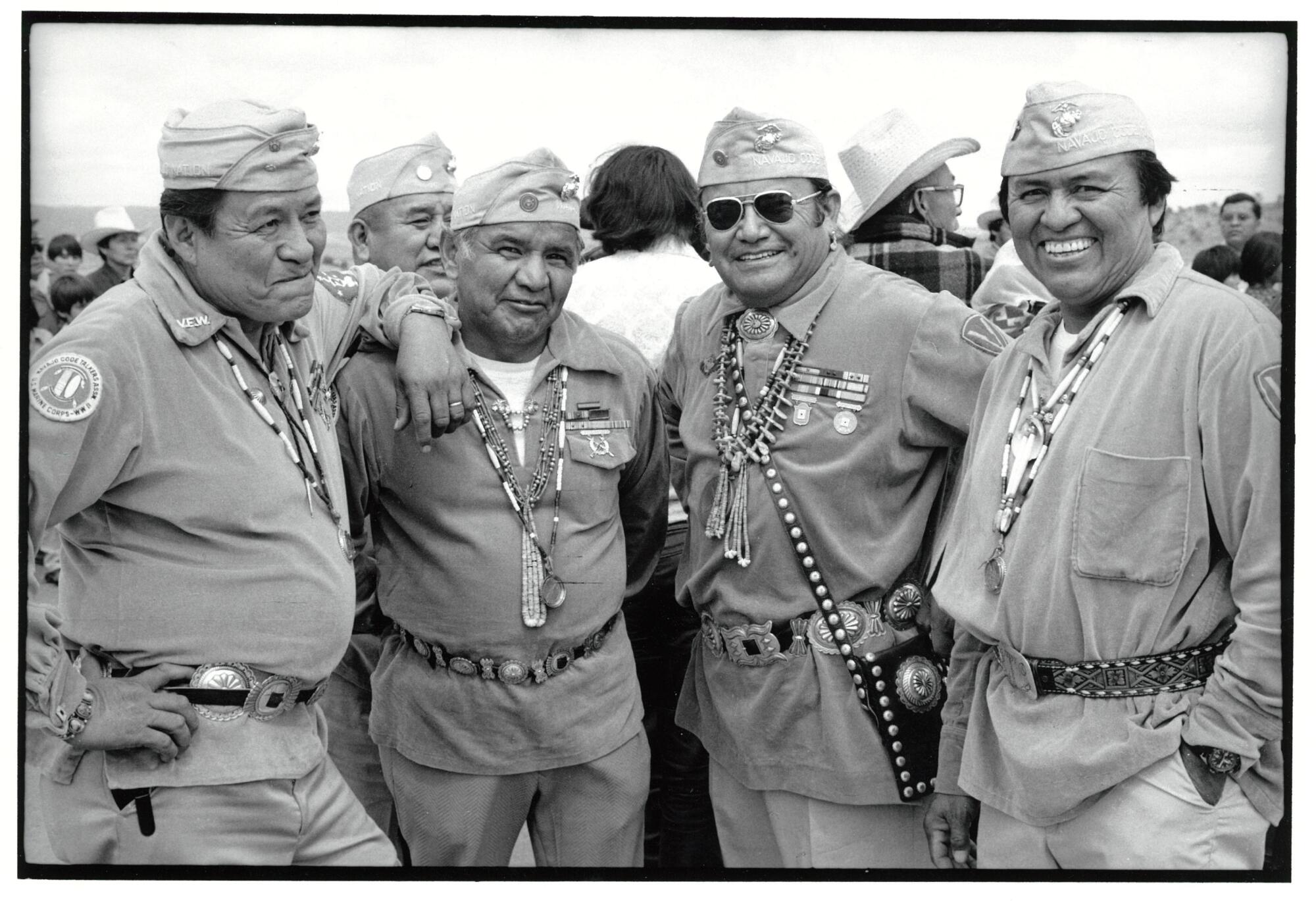
Kenji Kawano’s picture of those code talkers was taken in Window Rock, Ariz.
(Courtesy of Kenji Kawano)
::
Kawano, now 74, lives on the reservation along with his 68-year-old spouse Ruth, a Navajo. Their daughter Sakura is 41.
The partitions of their tidy home in Window Rock, capital of the Navajo Nation, are lined in black-and-white pictures. Classic cameras sit on a shelf, and a cramped darkroom is simply off the kitchen.
“Nowadays you’ll be able to see your image immediately,” Kawano stated. “Taking footage, driving residence and growing the movie takes without end,” however he likes “that second when the image is revealed.”
A few of his pictures have been on show at Window Rock’s Navajo Nation Museum final yr in an exhibit titled “Navajo Code Talkers: Via the Lens of Kenji Kawano.”
“It takes lots for me to have a non-Navajo’s work proven right here,” museum director Manuelito Wheeler stated. However Kawano has “spent nearly all of his life right here. He has a toddler who is an element Navajo, and so from that perspective, and from a Navajo cultural perspective, he has turn into a part of us. He’s an in-law and that goes a great distance right here.”
Kawano was born in Fukuoka, Japan, earlier than shifting to Gotemba, which is close to Mt. Fuji, when he was in third grade. He cherished American films reminiscent of ”Straightforward Rider” and “Midnight Cowboy” and westerns reminiscent of “She Wore a Yellow Ribbon.” He additionally cherished images and wished to review it in faculty, however his father couldn’t afford it.
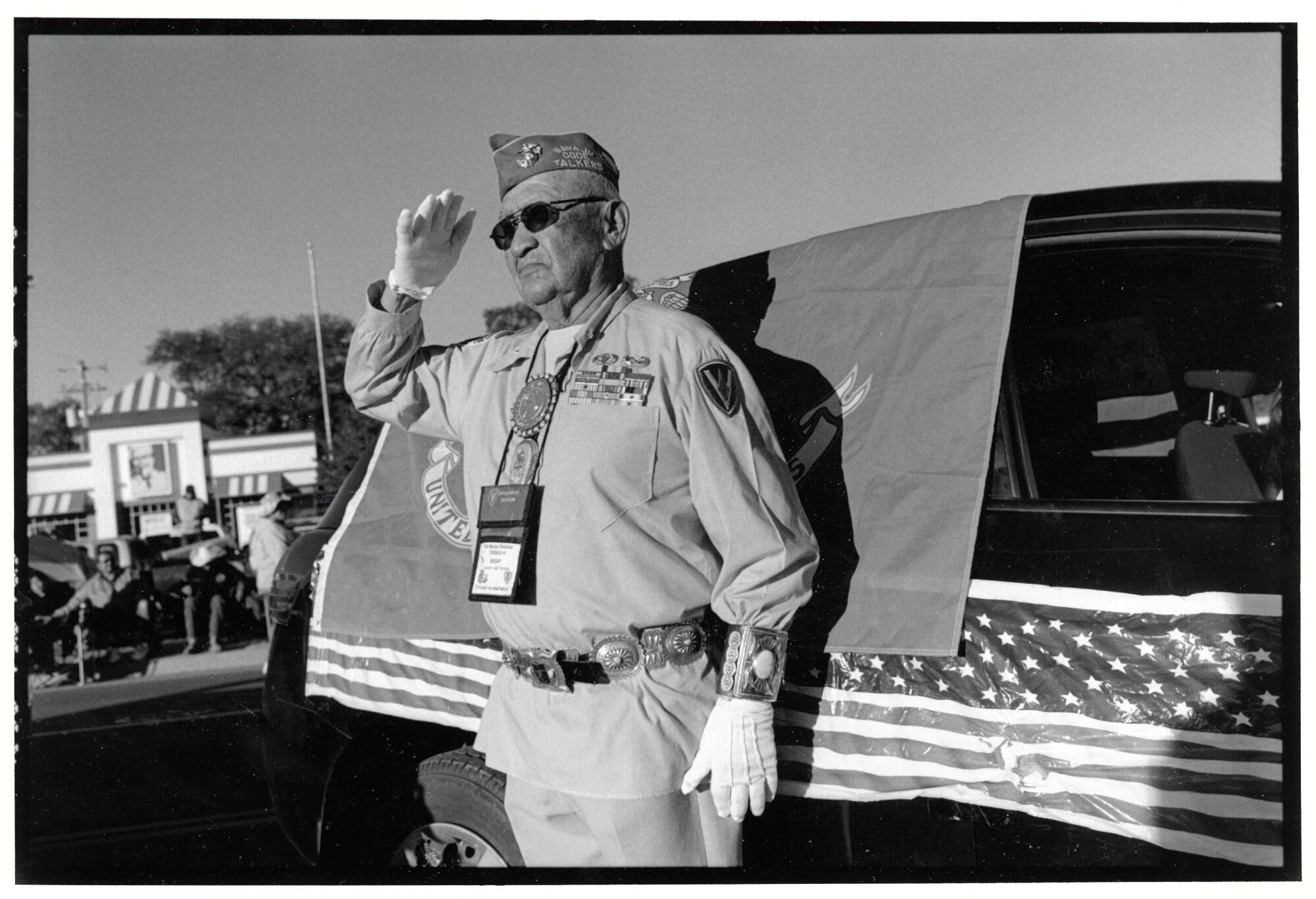
Throughout World Conflict II, Japanese cryptographers had been breaking U.S. army codes — seemingly at will — and Navajo, a fancy, little-known, tonal language, turned out to be an ideal answer to a dire drawback. Code talker Thomas H. Begay was photographed in 2014.
(Courtesy of Kenji Kawano)
Undeterred, Kawano flew to Los Angeles in 1973, the primary cease on what he hoped can be an excellent journey. His purpose was to land a full-time images job.
Armed with a backpack, a Pentax digicam and a transportable movie growing package, Kawano discovered an affordable lodge in Little Tokyo the place he may dwell and started taking footage of town and its inhabitants.
The proprietor of a close-by vintage store steered he go to the Navajo reservation, which spreads throughout components of New Mexico, Arizona and Utah. Kawano, who says he knew nothing about Native Individuals on the time, purchased a bus ticket to Gallup, N.M., and began his journey.
A neighborhood contact launched Kawano to a Navajo household in Fort Defiance, Ariz., who took him in. He washed dishes and cleaned the home in return for a spot to sleep. The remainder of his time was spent taking pictures on the reservation. At all times black-and-white, at all times on movie.
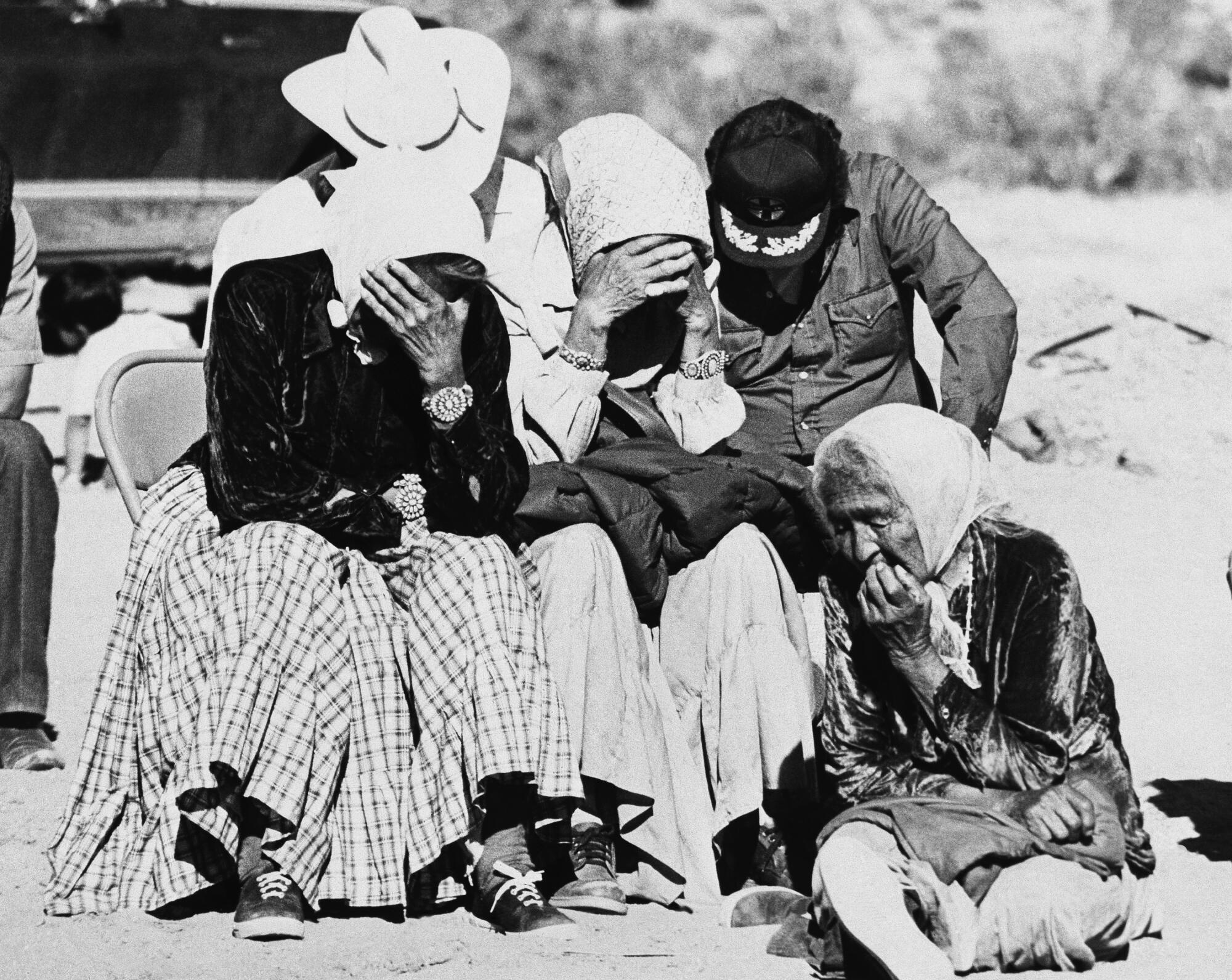
Kawano photographed Navajo girls weeping — as a result of they’d been ordered off their land — throughout a gathering in Cactus Valley, Ariz., in 1981.
(Kenji Kawano / Related Press)
His subsequent cease was tiny Ganado, Ariz., a reservation city, the place he pumped fuel and lived in a basement connected to the station. It had no warmth, electrical energy or plumbing, and he used the bathroom in the home subsequent door. When Kawano’s mom noticed pictures of the place, she wept.
“If you find yourself younger, you don’t suppose an excessive amount of or you’ll by no means act,” he stated. “It was an enormous journey for me.”
::
Kawano says he stood out on the reservation.
“The Navajo are curious by nature, particularly the youngsters. They’d observe me, this Asian man strolling round with a digicam, and ask what I used to be doing,” he stated. “You don’t see lots of Japanese individuals on the reservation.”
He spoke little English and even much less Navajo however took benefit of their curiosity to win their confidence.
Lots of the Navajo he encountered have been huge followers of martial arts films. On the time, movies reminiscent of “Enter the Dragon” and “Billy Jack” have been huge hits, promoting out theaters in Gallup for weeks.
“Bruce Lee was very talked-about in 1974. He was Chinese language, however they didn’t perceive the distinction between Chinese language, Japanese and Korean so they’d at all times ask me if I knew kung fu,” Kawano stated.
He didn’t, however he knew a couple of judo strikes, which, he stated, impressed the youngsters. When he was harassed after a soccer recreation in Ganado, he efficiently fended off the attacker with some well-placed strikes, cementing his repute as somebody to not mess with.
The Navajos progressively let Kawano into their world.
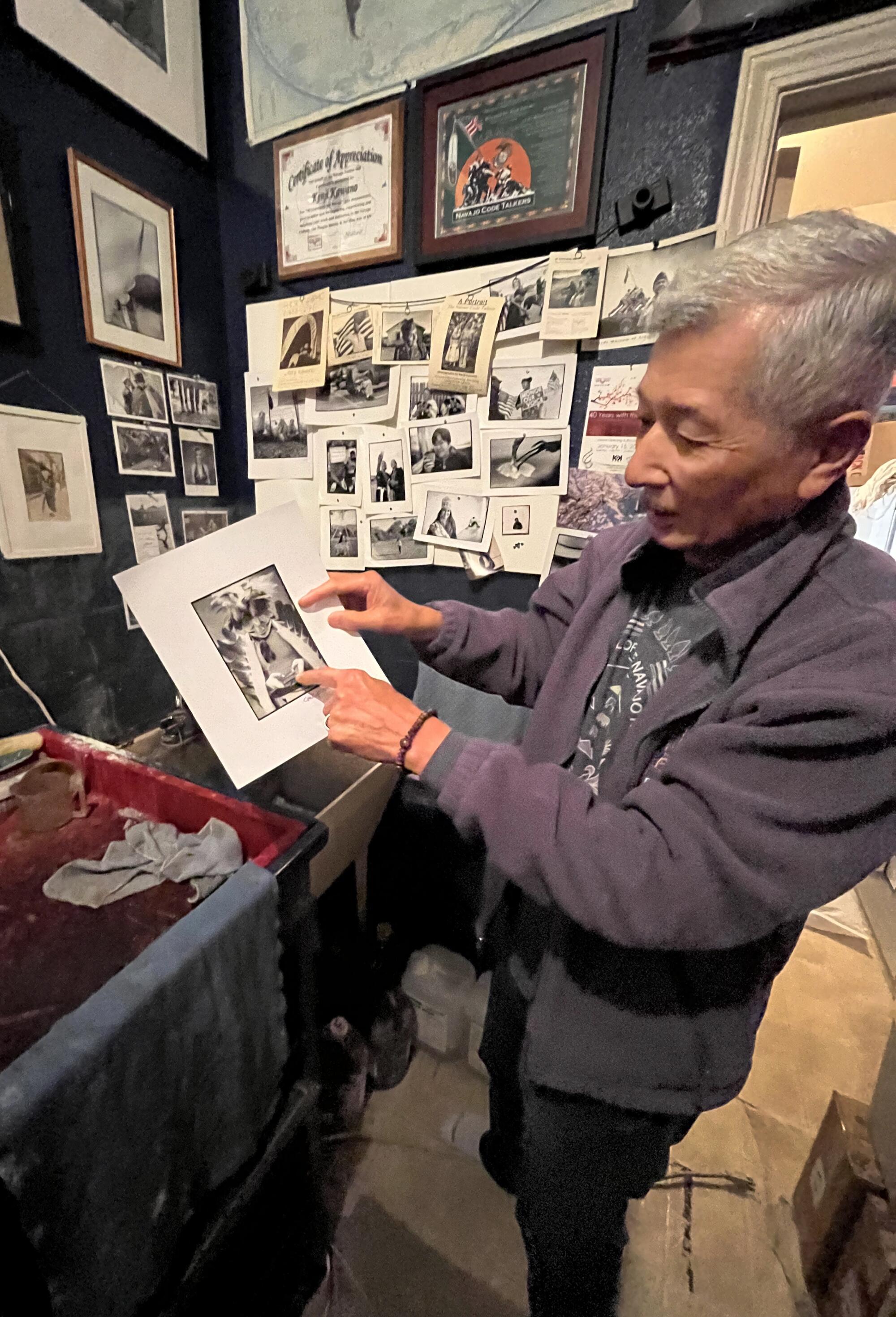
After World Conflict II, the code talkers have been sworn to secrecy about this system till it was declassified by the federal authorities in 1968. Kenji Kawano’s images is preserving their legacy.
(David Kelly / For The Instances)
As soon as, at a Christmas occasion, he met a father and son who sang conventional Navajo songs. They agreed he may {photograph} them at their home. “Years later the son got here to me and stated, ‘Do you keep in mind me?’’’ Kawano recalled. “He stated his dad had handed away, however he nonetheless has that image I took to remind him of him.”
Pictures didn’t pay the payments, so Kawano additionally labored as a janitor, upkeep man and college photographer on the now-closed School of Ganado, the place a lot of the college students have been Navajo.
He met Ruth Williams on the faculty in 1976. They’d go for walks and he’d sing her songs in Japanese. They married two years later.
“The whole lot about him was carefully tied to the best way I used to be introduced up — being disciplined, setting objectives and being lively achieve these objectives,” stated Ruth, a registered nurse and a photographer. “That was actually vital to me.”
Her father, an Military veteran, accepted Kawano instantly.
“My mom had her issues, however I believe after you began coming round, chopping wooden, getting water, they get to know you,” Ruth stated. “They noticed Kenji as a human being, and in the end that’s all that mattered.”
::
Whereas dwelling in Ganado, Kawano routinely hitchhiked to Window Rock for picture provides — which is how he met Carl Gorman.
“Again within the day, that was my dad’s factor, choosing up hitchhikers,” Zonnie Gorman stated. “He cherished to have conversations and cherished to interact with individuals, particularly anyone so very totally different.” On the time, her father was the pinnacle of the Navajo Code Talkers Assn., and he launched Kawano to a number of the others.

The documentary “The Warrior Custom” included footage of Navajo code talkers on responsibility within the Bougainville area of Papua New Guinea.
(Nationwide Archives and Information Administration)
The code talkers weren’t well-known then. After the struggle, they have been sworn to secrecy about this system till it was declassified by the federal authorities in 1968. Kawano stated the code talkers held their first reunion that yr and started participating within the annual Navajo Truthful round 1970.
In 1982, then-President Reagan declared Aug. 14 Nationwide Code Talkers Day, which inspired extra of the boys to share their experiences. The Navajo Nation had already initiated an annual parade of their honor.
Kawano took footage of the boys on the parades, however he wasn’t happy. He wished portraits that have been distinctively Navajo, so between 1975 and 1989 he tracked down as most of the 200 or so survivors as he may to create particular person portraits. He ultimately photographed 110 code talkers.
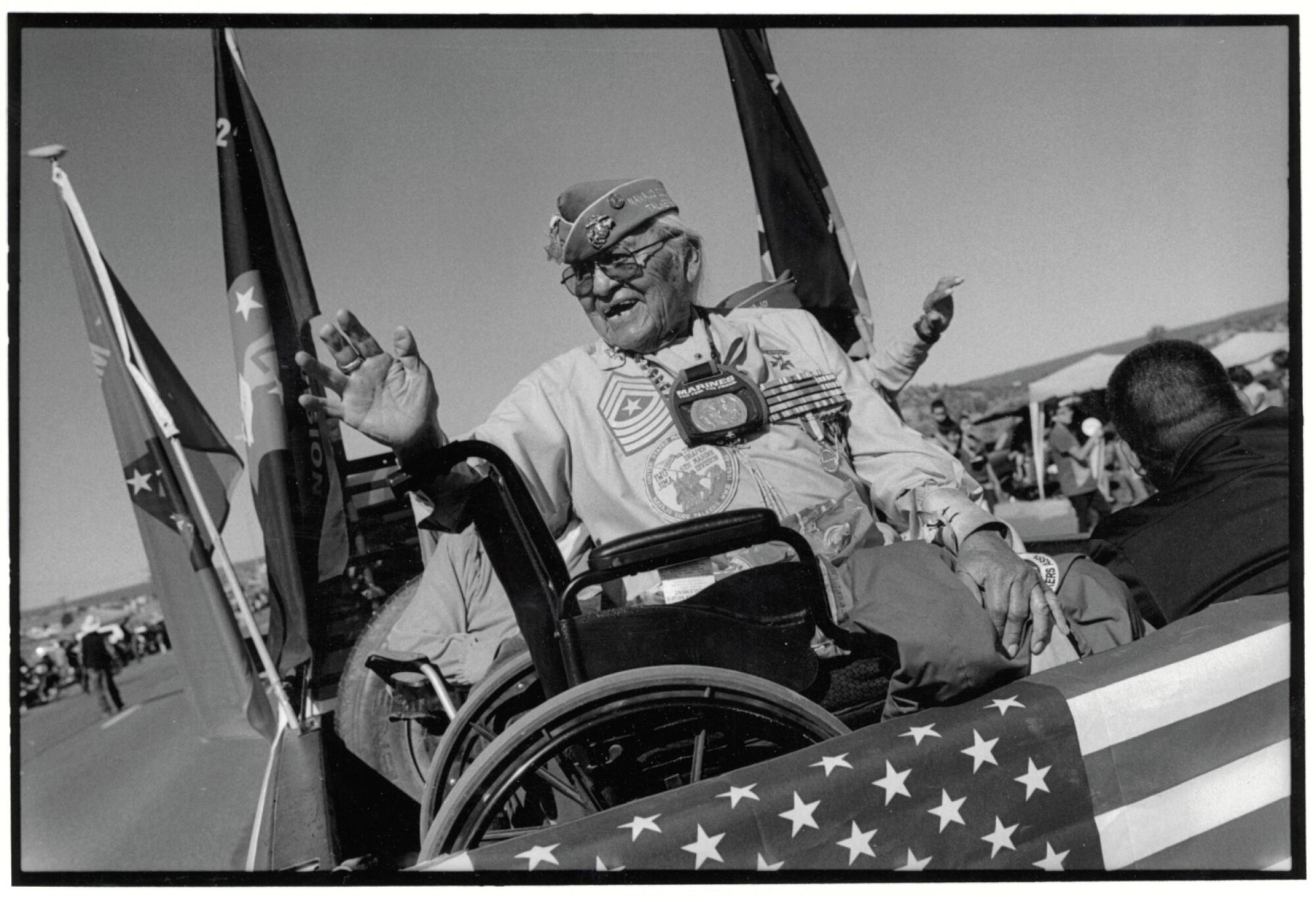
Kenji Kawano, who photographed Teddy Draper Sr. in 2016, is a perfectionist. He’d drive three hours or extra on a reservation the scale of West Virginia for a photograph, explaining, “After I developed the movie at residence and wasn’t completely happy, I’d drive three hours again to retake it.”
(Courtsey of Kenji Kawano)
Within the Eighties, solely about 20% of Navajo properties had telephones. If he discovered a code talker’s handle, Kawano would simply present up. A couple of of the boys he encountered refused to cooperate. They’d had pals who’d been killed by Japanese troopers, and his request didn’t sit properly. However most of them ultimately stated sure.
“Generally I’d drive for hours, knock on the door and there was nobody there,” Kawano stated. “In the event that they have been residence, I’d introduce myself and inform them about my undertaking. Most have been completely happy to share their lives and experiences. Right here was their previous enemy and but they’d conform to work with me.”
Kawano photographed code talkers in entrance of conventional Navajo dwellings. He stood them beside sheep, a central a part of tribal life. His pictures have been intimate; their lined faces, expressive.
He was a perfectionist. He’d drive three hours or extra on a reservation the scale of West Virginia for a photograph, explaining, “After I developed the movie at residence and wasn’t completely happy, I’d drive three hours again to retake it.”
His first e-book of images, referred to as “Warriors: Navajo Code Talkers,” was printed in 1990, and that led to displays in Japan, Germany, Phoenix, Los Angeles, Virginia, Albuquerque, the Air Pressure Academy in Colorado Springs and the Navajo Nation Museum in Window Rock.
He requested each man he photographed for the e-book to jot down down one reminiscence of the struggle:
“I participated within the bloody battle of Iwo Jima … They advised us to safe communications and phone wire beneath fight situations on the island inside three days. However it took a few month,” Teddy Draper Sr. wrote.
Wilson Value recalled how “all of us cheered and jumped round” when the American flag was flown atop Mt. Suribachi on Iwo Jima.
“Whereas I used to be stationed in Guam. I noticed a soldier step on a landmine. Each of his legs and one hand have been destroyed,” John Kinsel Sr. wrote. “He requested for a smoke, saying, ‘I nonetheless have one hand.’”
After the e-book printed, code talkers who’d been initially reluctant to be photographed modified their minds, and Kawano was besieged with requests. He printed one other e-book of portraits and aerial images of the Navajo Nation. He adopted that with a e-book targeted on Navajo girls.
Kawano additionally wrote a e-book in Japanese about dwelling on the reservation, prompting NHK, Japan’s largest broadcast community, to create a 2004 documentary on his life referred to as “Japanese Who Stay Far Away from Japan.”
“They couldn’t perceive why I’d dwell right here,” Kawano stated. “However I discovered what I cherished right here, not in Japan.”
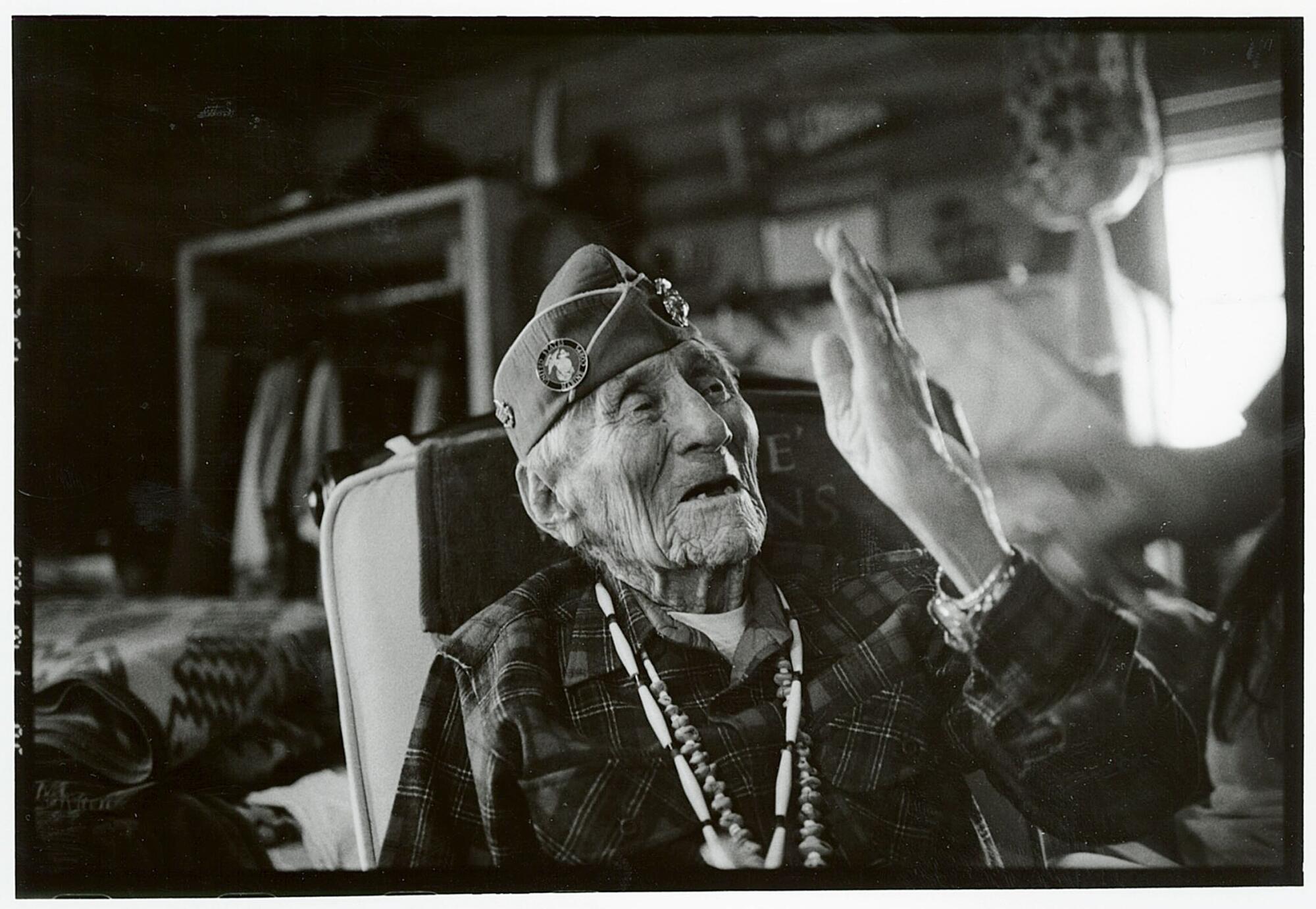
Kenji Kawano photographed John Kinsel Sr., 107, certainly one of three remaining code talkers.
(Courtesy of Kenji Kawano)
The code talkers anchored his life right here. He spent hours speaking and sharing tales, and so they tolerated his fussiness, in search of simply the precise angle, simply the precise gentle. Kawano’s humble, reserved method mirrored their very own, kin of the boys noticed.
“I spent extra time with them than my very own father,” Kawano stated.
::
John Kinsel Sr., 107, the oldest of the three surviving code talkers, lives in rural Lukachukai, Ariz., along with his son Ron, 71, in a cabin he inbuilt 1950.
A Kawano picture of Kinsel hangs above his mattress. Feathers dangle from the ceiling, and conventional medicines and herbs in small leather-based pouches are shut by. When Kinsel just lately started seeing visions of his late horse Yoyo operating towards him, a medication man held a ceremony to dispel the phantoms.
Kinsel fought on Iwo Jima, Guadalcanal and different Pacific battlefields. Now frail and onerous of listening to, he spends most of his time sleeping, fueling himself with mutton stew — his “medication” — his son says.
Questions needed to be shouted. His solutions have been halting. However he lit up on the point out of Kawano, clutching a customer’s arm and leaning in shut.
“Kenji has used his footage to indicate the world what the code talkers did,” Kinsel stated, propped up in a chair and carrying a turquoise belt and necklace. “If it wasn’t for him, we’d not be identified.”
1
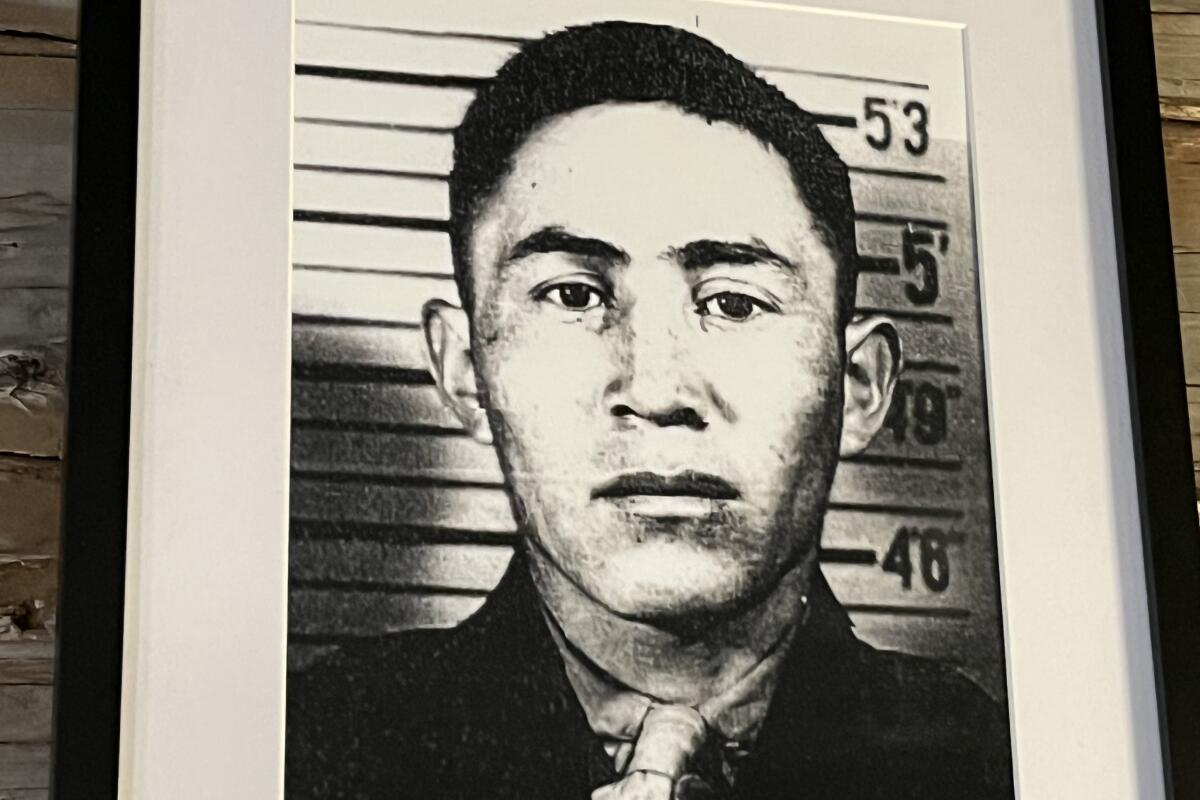
2

1. Kenji Kawano has been documenting the Navajo code talkers for half a century. (David Kelly / For The Instances) 2. A portrait of a Navajo code talker. (David Kelly / For The Instances)
Again in Window Rock, Kawano flicked by a few of his pictures. He stated he has sufficient materials for 4 or 5 extra books. He is aware of these are the final days of the code talkers, and he hopes his work introduced their tales to a wider world.
“I completed greater than I anticipated,” he stated quietly. “The story received’t finish when they’re gone; the story will go on.”
Kelly is a particular correspondent.




